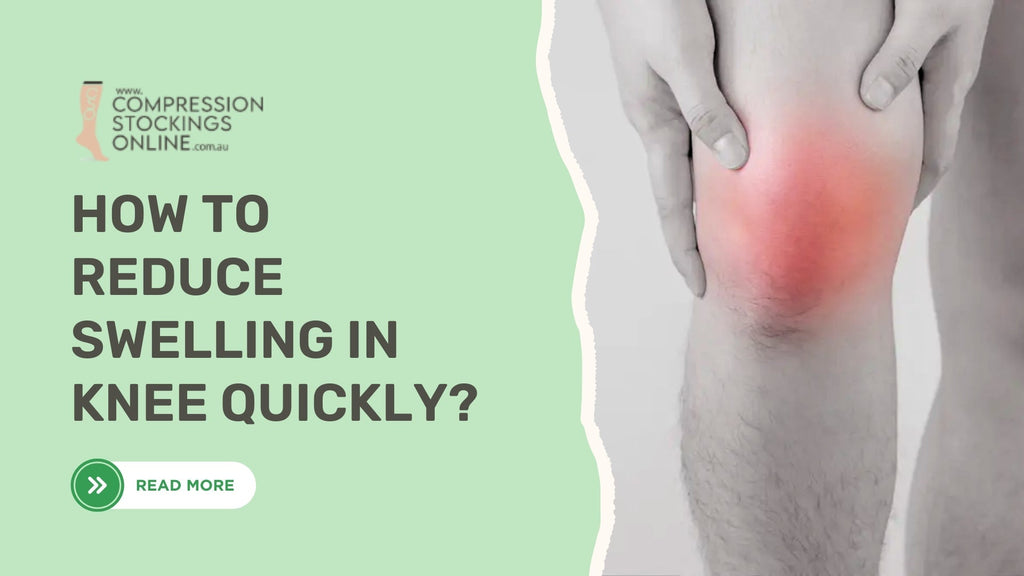
A swollen knee can make simple things, like climbing stairs, sitting at work, or even getting a good night’s sleep, feel frustrating. Whether it’s from an injury, arthritis, or fluid build-up, the swelling often raises the same question: how to reduce swelling in the knee quickly?
In this guide, you’ll learn what works in the first few hours, the red flags you shouldn’t ignore, gentle exercises that help move fluid out, recovery timelines, and how compression gears fit into daily relief. We’ll also answer common questions people search for when dealing with a swelled up knee, so you know exactly what to do next.
Quick Answer (What To Do In The First Few Hours)
When your knee swells, acting early is key. The RICE method, Rest, Ice, Compression, Elevation, is the fastest, most trusted approach. Here’s how to use it straight away:
How to reduce swelling in knee quickly, 5 steps you can start now
1. Rest (unload the knee)
Keep weight off the joint as much as possible. Short rest breaks limit extra irritation to tissues already inflamed from the injury or strain.
2. Ice (15–20 minutes per session)
Apply cold packs for 15–20 minutes every 2–3 hours in the first 48 hours. Cooling reduces blood flow and nerve activity, which calms pain and helps reduce knee swelling fast. Clinical data show local cooling can lower tissue temperature by up to 10 °C, slowing inflammatory processes.
3. Compression (knee sleeve or wrap)
A compression knee sleeve or wrap provides gentle, constant pressure, preventing fluid from pooling. Elastic compression helps reduce swelling and improve function after soft-tissue injuries.
Elevation (above the heart)
Place your leg on pillows so the knee sits higher than your heart. Gravity helps fluid drain away, easing pressure. Aim for 20–30 minutes at a time, a few times a day.
Short-term pain relief if safe
Over-the-counter anti-inflammatories (like ibuprofen) may help reduce inflammation and pain, but only if you have no medical reasons to avoid them.
This simple routine, rest, ice, compression knee sleeve, and elevation, is your best first line in the first 24–72 hours after a knee swelling after injury.
For added support during recovery, check out our Compression Wraps designed for wound care and knee relief.
Is It Dangerous to Have Fluid on the Knee? (Know the Red Flags)
Fluid on the knee, also called knee effusion or water on the knee, is a sign, not the disease. The risk depends on the cause.
Why can it be dangerous?
- Infection (septic arthritis). This is an emergency because bacteria inside the joint can damage cartilage within days if treatment is delayed. Reviews from AAFP report 90-day mortality ≈ 7% overall, rising to 22–69% in people ≥80 years, and poor functional outcomes in ~24–33% of cases even with treatment. Reviews from PMC confirm joint destruction can progress quickly and mortality can range ~3%–25% depending on cohort and comorbidities.
- Severe injuries. A large, rapid effusion after trauma can signal major structural injury. Long-term risk is real: about 50% of people develop knee osteoarthritis 12–14 years after ACL reconstruction, per a 2022 review.
- Chronic inflammatory or crystal conditions. Gout, rheumatoid arthritis, and flares can drive repeated effusions; ongoing inflammation raises the chance of cartilage loss and disability.
- Complications of untreated swelling. Ongoing effusion links to muscle wasting, stiffness and a Baker’s cyst (fluid pocket behind the knee), all noted in clinical resources for swollen knees.
Long-term joint damage from arthritis can worsen swelling. See our guide on How to Cure Osteoarthritis for practical management tips.
What’s okay vs not okay?
- Usually safe at home: mild swelling, no redness or fever, still able to walk, pain easing with rest, ice, compression, and elevation.
- See a doctor immediately: if the knee is red, hot, very painful, if there is fever, if you can’t bear weight, or if swelling is sudden and severe after injury.
Move the Fluid Out (Gentle Exercises Once Pain Allows)
Once the sharp pain and heat ease, gentle movement is one of the best ways to reduce a swelled up knee. Muscles in the calf and thigh act like pumps, helping lymph and venous blood carry excess fluid away from the joint. This prevents stiffness and keeps circulation active without stressing the knee.
Easy moves for a “swelled up knee” (no equipment)
These can be done on a bed or mat, as long as they are pain-free:
- Ankle pump exercises: flex and point your foot up and down for 20–30 reps to keep circulation flowing.
- Heel slides for knee: lie on your back and gently slide your heel towards your hips, then return.
- Quad sets: tighten the thigh muscle (quadriceps), hold for 5 seconds, then relax. Repeat 10–15 times.
- Short-range knee bends: sit on a chair and bend the knee slightly, staying in a comfortable range.
- Supported leg raise: keep the leg straight and lift it a few centimetres off the surface, using the thigh muscles to control the movement.
Clinical guidelines confirm that simple, low-load exercises can improve joint mobility and help manage swelling in the early phase of recovery.
See our guide on How to Improve Blood Flow to Feet for more tips.
Pick the Right Compression (Stockings, Wraps, Sleeves) Fast Relief + Day Comfort
Compression helps manage a swollen knee by applying gentle pressure that reduces fluid build-up and supports circulation. Learn more in our blog on What Do Compression Stockings Do.
Knee sleeve vs wrap vs compression stockings
- Compression knee sleeve: best for daily use or exercise; provides even pressure around the joint.
- Knee compression wrap: adjustable pressure; useful when swelling changes through the day.
- Knee-high compression stockings: helpful for all-day standing, travel, or people with swelling that extends below the knee.
Fit and safety
- Choose mild to moderate compression (15–30 mmHg) for comfort during normal activity.
- Measure calf and thigh circumference for the right size (see our compression stockings sizing guide).
- Stop or adjust if you notice numbness in your legs, tingling, or skin colour change.
- Supportive shoes and alternating cold/heat cycles, as recommended on Voltaren AU, can add extra relief.
Check out our full range of Compression Stockings designed to support circulation and ease knee swelling, and don’t miss our Compression Stockings Accessories, including donning devices and care gels for everyday comfort.
What Helps By Tonight vs This Week (Timeline You Can Trust)
Here’s what you can expect from your knee swelling timeline, and what to do at each stage.
Tonight (0–24 hours):
- Stick to rest, ice (15–20 minutes every 2–4 hours), compression, and elevation. Slide in gentle ankle pumps if they don’t hurt. This helps kick off healing. These steps are standard care for soft-tissue knee injuries.
2–3 Days:
- Start short, flat-ground walks and easy moves, like knee bends or straight-leg raises, if swelling and pain allow. NHS instructions encourage this “gentle return to movement” in the early days. For more guidance on safe recovery steps, see the NHS acute knee injury exercise guide.
1 Week+:
- If swelling has reduced, add light strength work for glutes, quads, and calves, think bridges, mini-squats, or seated leg extensions. Steady strengthening helps prevent stiffness and supports long-term recovery.
"How long till the swelling goes down?", real-world ranges
- Minor injuries or soft-tissue bruises: swelling often eases within a few days to a week.
- Moderate injuries (like sprains): expect 3–6 weeks for significant improvement.
- Severe injuries (e.g., ligament tears or after surgery): full healing may take 6–12 weeks or longer.
For more everyday relief tips, check out our guide on How to Get Rid of Knee Pain.
You may be interested in this related guide on How to Get Rid of Swollen Ankles Fast.
Conclusion
Knee swelling can feel worrying, but acting early with rest, ice, compression, and elevation makes a big difference. We walked through quick first-aid steps, red flags to watch for, gentle exercises that move fluid out, timelines for recovery, and how to choose between a compression knee sleeve, wrap, or knee-high stockings for everyday support.
Pair your daily stretches with our trusted compression stockings and wraps from brands like Juzo, Jobst, Sigvaris, and Venosan. Explore more at Compression Stockings Online.
Frequently Asked Questions
What is the fastest way to heal a swollen knee?
The fastest approach is the RICE method (rest, ice, compression, elevation) in the first 48 hours. Adding a compression knee sleeve or wrap keeps swelling controlled throughout the day.
How to sleep with a swollen knee?
Sleep on your back with the leg elevated on a pillow under the calf so the knee stays slightly higher than the heart. This helps swelling ease overnight.
How do you massage your knees to reduce swelling?
Light, upward strokes around the calf and thigh can help encourage lymph drainage. Always massage towards the heart and avoid pressing directly on the swollen joint.
What can I rub on a swollen knee?
Cooling gels or creams with menthol can ease discomfort. Anti-inflammatory gels like diclofenac (found in Voltaren) may also help if safe for you.
Should I keep my knee straight or bent when resting?
Keep it slightly straight with a soft bend. Fully locked knees can stiffen, while deep bends can push fluid forward. Aim for a comfortable middle range.

Leave a comment